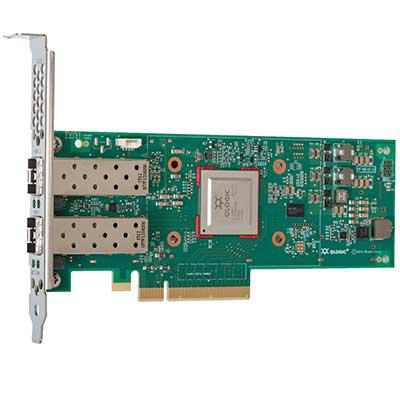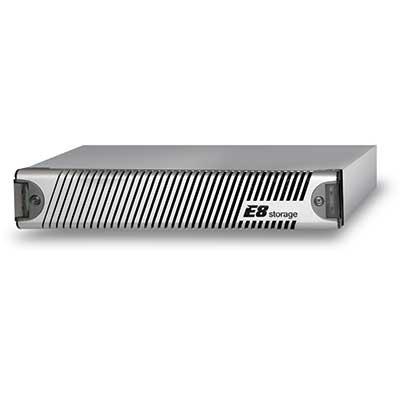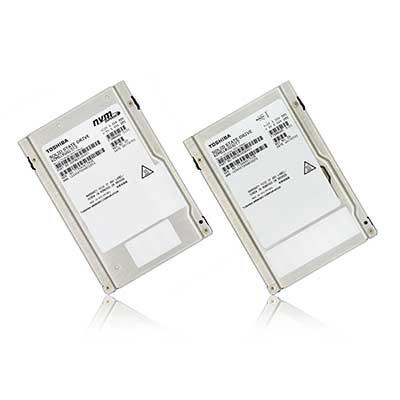19 Flash Storage Products Heating Up The Storage Market

Flash Storage Takes Center Stage
The Flash Memory Summit in Santa Clara, Calif., was the place to be for the latest in flash storage and flash memory technology, with vendors showing off the latest in all-flash arrays, SSDs, persistent memory, components, and even the software to manage flash performance.
Research firm IDC in June reported that all-flash array vendors generated nearly $1.4 billion in revenue during the first quarter of 2017, which was up 75.7 percent yea -over year. Meanwhile, hybrid flash array sales reached $2.0 billion during the first quarter.
Here's a look at the latest from 19 vendors in this red-hot industry.

AIC Intel Purley Platform With Samsung NGSFF
AIC, City of Industry, Calif., used the Flash Memory Summit to unveil a new 1U server based on dual E5-2600v5 Intel Xeon Scalable processors that include up to 36 Samsung Next Generation Small Form Factor (NGSFF) PCIe NVMe SSD hot-swap drives to provide a high-density, all-NVMe flash storage array. With a 16-TB capacity per Samsung NGSFF NVMe SSD, the total raw capacity is up to just under 0.6 petabytes in 1U. The company said the array can offer up to 300-Gbps Ethernet performance with 10 million IOPS, making it suitable for scale-out, scale-up, database, real-time analytics, deep learning, content distribution networks and more.

Attala Composable Storage Infrastructure Technology For Cloud
Attala Systems, an early stage developer of next-generation storage and networking technology, came out of stealth mode at the Flash Memory Summit to demonstrate its new high-performance storage technology targeting cloud environments such as those operated by cloud service providers, e-commerce sites, MSPs, telco providers, financial services and real-time digital enterprises. The San Jose, Calif.-based company said its elastic block storage technology is an end-to-end offering featuring FPGA-based hardware and cloud-focused self-learning orchestration and provisioning software to meet cloud storage performance requirements, and is purpose-built for cloud storage infrastructures.

Cavium Demos NVMe over Fabrics
Cavium, the San Jose, Calif.-based developer of networking and storage semiconductors and owner of the QLogic line of storage and networking adapters, showed a number of NVMe over Fabric products. NVMe over Fabrics is an emerging technology aimed at providing efficient scaling of NVMe-based SSDs over data center fabrics including Remote Direct Memory Access (RDMA) networks such as iWARP and RoCE, as well as Fibre Channel. Cavium offers NVMe over Fabric over both Universal RDMA and Fibre Channel adapters. This includes the QLogic 2690 series of enhanced Gen 5 and 2700 series of Gen 6 Fibre Channel adapters, which are FC-NVMe, as well as Cavium FastLinQ 45000 and 41000 series Ethernet network interface cards (shown in the photo) supporting Universal RDMA to scale out NVMe over a general-purpose Ethernet fabric.

Datera Demos SSD-powered Data Infrastructure-as-a-service
Datera, a Sunnyvale, Calif.-based developer of elastic block storage for on-premises clouds, used Flash Memory Summit to showcase a policy-based, self-managing web-scale data infrastructure that includes Samsung Z-SSD flash storage and conventional SATA flash. The company also showed how the infrastructure could change workloads in real time.
The Datera offering is software deployed on commodity x86-based servers with support for mixed media types, and supports orchestration and virtualization layers including CloudStack, Docker, Kubernetes, Mesosphere, OpenStack and VMware. Using Samsung Z-SSD flash, Datera said it can offer per-node performance of more than 400,000 IOPs with under 100 microseconds of latency.

E8 Leverages Intel Optane SSDs For Performance, Low Latency
E8 Storage, Santa Clara, Calif., showed its new E8-X24 centralized NVMe appliance, which takes advantage of dual-port Intel Optane SSDs to provide high-performance storage and low latency for mission-critical applications. The E8-X24 combines Intel’s Optane high-speed, non-volatile solid-state storage and E8 Storage’s high-performance centralized NVMe solution, and is targeted at such high-performance applications as real-time, high-volume trading. The E8-X24 is available for testing with select customers.

Gen-Z Consortium Presents World’s First Gen-Z MultivVendor Demonstration
The Gen-Z Consortium, which is an organization of over 40 server, storage and semiconductor vendors developing an open systems interconnect for high-speed, low-latency, memory-semantic access to data and devices that could compete with technologies like Intel's 3D XPoint, was at Flash Memory Summit to unveil the world’s first Gen-Z multivendor technology demonstration. The initial demonstration showed FPGA-based Gen-Z adapters connecting compute nodes to memory pools through a Gen-Z switch to build a fabric with multiple server and memory vendors. The organization also showed the scalable prototype connector defined by the Gen-Z Consortium running at 112 giga-transfers per second.

Intel Intros 'Ruler' SSD Form Factor, Updates Data Center SATA SSDs
Intel used the Flash Memory Summit to introduce its "ruler" SSD form factor. Unlike standard SSDs that feature legacy 2.5-inch and 3.5-inch form factors, the ruler form factor SSDs feature a long, skinny shape that make them easier to plug directly into PCIe card slots. Intel said the new form factor will allow vendors to build 1U servers with up to a petabyte of all-flash storage capacity.
Intel also showed off its new high-performance, dual-port Intel SSDs and Intel 3-D NAND SSDs, and introduced a new series of SATA-based SSDs with the company's latest SATA firmware tied to high-density 32-layer 3-D NAND.

IntelliProp Gen-Z Persistent Memory Controller Combines DRAM, NAND
Longmont, Colo.-based storage and memory semiconductor developer IntelliProp unveiled its new IPA-PM185-CT Cobra Gen-Z Persistent Memory Controller. The controller combines DRAM and NAND and sits on the Gen-Z fabric instead of the memory bus. Cobra can support byte addressability to the DRAM cache and block storage addressability to NAND flash, and supports up to 32 GB of DRAM and 6 TB of NAND.
IntelliProp also showed its IPC-NV164-HI NVMe host accelerator IP core, which is targeted at developers of FPGA and ASIC chips looking for high-performance connectivity to NVMe storage devices over PCIe. The company also said it is now shipping new NVMe products including an NVMe-to-NVMe bridge and an NVMe-to-SATA bridge.

Kaminario K2.N and Kaminario Flex
Kaminario, a Needham, Mass.-based developer of all-flash storage arrays, unveiled a couple of new offerings that leverage NVMe technology for performance and scalability in private cloud environments.
The Kaminario K2.N is an end-to-end NVMe-based all-flash array with scale-out, active-active capability with NVMeF Fibre Channel and iSCSI front-end connectivity and a back end based on converged Ethernet and NVMeF. Kaminario Flex (pictured) is a software platform for managing composable storage infrastructures that works with the K2.N to enhance operational efficiency and organizational agility while building cloud-scale, shared storage environments.

Micron 10-TB-plus NVMe SSDs
The new Micron 9200 SSD from Micron, which the Boise, Idaho-based memory developer called one of the first NVMe SSDs on the market with a capacity exceeding 10 TB, is built using 3-D NAND. The SSDs are available in capacity points ranging rom 1.6 TB to 11 TB, and can be ordered in traditional or hot-swappable U.2 form factors. They feature transfer speeds of up to 5.5 GBps and up to 900,000 read IOPS, and come with Micron's Flex Capacity feature that allows users to tune and retune the drive’s capacity to deliver application and workload-optimized performance.

Mobiveil Demos New 3D NAND SSD Tech
Mobiveil, a Milpitas, Calif.-based developer of silicon-based intellectual property platforms and services, showed its new FPGA-based sSSD) development platform and its low-density parity-check-based flash characterization system targeting the development of 3-D NAND-based storage.

Netlist HybriDIMM Storage Class Memory
Netlist, an Irvine, Calif.-based developer of high-performance modular memory subsystems, demonstrated its HybriDIMM storage class memory product with the widely used MongoDB and Redis open-source databases running concurrently. The company said MongoDB exercises HybriDIMM's in-memory channel block storage capabilities while the Redis in-memory database utilizes memory semantics to achieve a true persistent memory offering.
HybriDIMM combines DRAM and NAND flash with intelligent "on-DIMM" co-processing to manage data transfers between on-DIMM storage and the server. It is recognized by any x86-based server as a standard LRDIMM with no BIOS modifications or system changes. HybriDIMM can operate as a server's main memory, as block storage or as persistent memory.

Nimbus Data ExaDrive
Nimbus Data unveiled ExaDrive, a new software and multiprocessor offering the Irvine, Calif.-based company said will help OEMs build next-generation SSDs with capacities of up to 500 TB by the year 2020. Costa Mesa, Calif.-based Viking Technology and Newark, Calif.-based Smart Modular Technologies are already shipping 25-TB and 50-TB SSDs featuring the ExaDrive technology for cloud infrastructure, technical computing and digital content storage., Nimbus Data said.
Unlike conventional SSD technology, which is based on a single flash controller, ExaDrive uses a distributed multiprocessor architecture to manage higher capacities. ExaDrive employs multiple ultra-low-power ASICs to error correction, while an intelligent flash processor provides wear-leveling and capacity management in software.

Samsung Intros V-NAND Memory Products
Samsung Electronics unveiled new V-NAND (Vertical NAND) memory devices and technology it said are targeted at accelerating next-generation data processing and storage systems.
New from Samsung was a 1-terabit V-NAND chip. Slated for availability in 2018, the chip is expected to allow Samsung to pack 2 TB of memory in a single V-NAND package. Samsung also sampled what it called the industry’s first 16-TB NGSFF SSD (pictured) aimed at high-capacity, high-performance systems. The company showed a reference server system that packs 576 TB in a 1U device using 36 16-TB NGSFF SSDs with the ability to process about 10 million random read IOPS. These SSDs are slated to ship by year-end. The company also showed its first Z-SSD product, the SZ985, which features only 15 microseconds of read latency time, which Samsung said is about one-seventh that of NVMe SSDs.

Seagate Expands Nytro Flash Storage Portfolio
Seagate Technology unveiled enhanced versions of two of its SSDs: the Nytro 5000 M.2 NVMe SSD and the Nytro 3000 SAS SSD. The Cupertino, Calif.-based company also highlighted its 64-TB NVMe add-in card that provides 13 GBps of read speed, Seagate claimed as the fastest and highest-capacity SSD ever demonstrated.
The Nytro 5000 (pictured) NVMe SSD features 2 TB of capacity with a random write performance of up to 67,000 IOPS, or double the performance of the previous version. The SAS-based Nytro 3000 SSDs offer up to 15 TB of capacity with up to 2,200 MBps in sequential read performance through a 12-Gbps SAS interface.

Silicon Motion Expands PCIe NVMe SSD Controller Portfolio
Silicon Motion Technology, the Milpitas, Calif.-based developer of NAND flash controllers for solid-state storage devices, introduced a broad portfolio of PCIe-based NVMe SSD controllers, including new controllers for client devices, mainstream servers, and a DRAM-less controller supporting the BGA form factor. New to the company's product line card is the SM2262EN, a high-high performance mainstream client SSD controller that delivers peak sequential read transfer speeds of up to 3,500 MBps and write transfer speeds of up to 3,000 MBps, with random read and write IOPS of up to 370,000 and 300,000. A lower-cost version, the SM2263XT, is a DRAM-less controller solution for 2-in-1 systems, Chromebooks and mobile devices.

Solarflare Partners With Samsung, Supermicro On NVMe Fabric Based On TCP
Solarflare demonstrated what it called the world’s first NVMe over Fabric based on the TCP protocol. The Irvine, Calif.-based company, in partnership with array maker Supermicro and SSD maker Samsung, showed how customers can leverage the native Ethernet transport and 90 percent of the 100 million Ethernet ports shipped annually to help open the market for NVMe fabrics without the need for lesser-known high-bandwidth, low-latency protocols as iWARP and RoCE. The company expects its XtremeScale network interface cards with NVMe over TCP support to be commercially available late this month.

Supermicro 1U Petabyte NVMe Storage System
Supermicro, San Jose, Calif., unveiled a new all-flash NVMe-based storage system that utilizes a total of 32 Intel "ruler" format SSDs to support up to a half-petabyte of high-performance capacity in a 1U form factor as the new SSDs are rolled out later this year. The 1U system is expected to support a full petabyte early next year with the planned release of 32-TB "ruler" SSDs, the company said.

Toshiba Unveils New Enterprise SSDs
Irvine, Calif.-based Toshiba America Electronics Components showed off two new flagship enterprise SSDs it said are expected to be available by year-end. Both feature the company's latest 64 layer, 3-bit-per-cell enterprise-class TLC BiCS flash technology.
The new TMC PM5 series offers up to 30.72 TB in a 2.5-inch form factor with up to 3,350 MBps of sequential read and 2,720 MBbs of sequential write in MultiLink mode and up to 400,000 random read IOPS in narrow or MultiLink mode. The company said the PM5 series gets performance close to that of PCIe while maintaining compatibility with legacy infrastructures. For more performance, the company introduced new NVMe SSDs that connect to PCIe ports and are NVMe-over-Fabric-ready. They include a DRAM buffer, and provide performance of up to 800,000 random read and 240,000 random write IOPS.